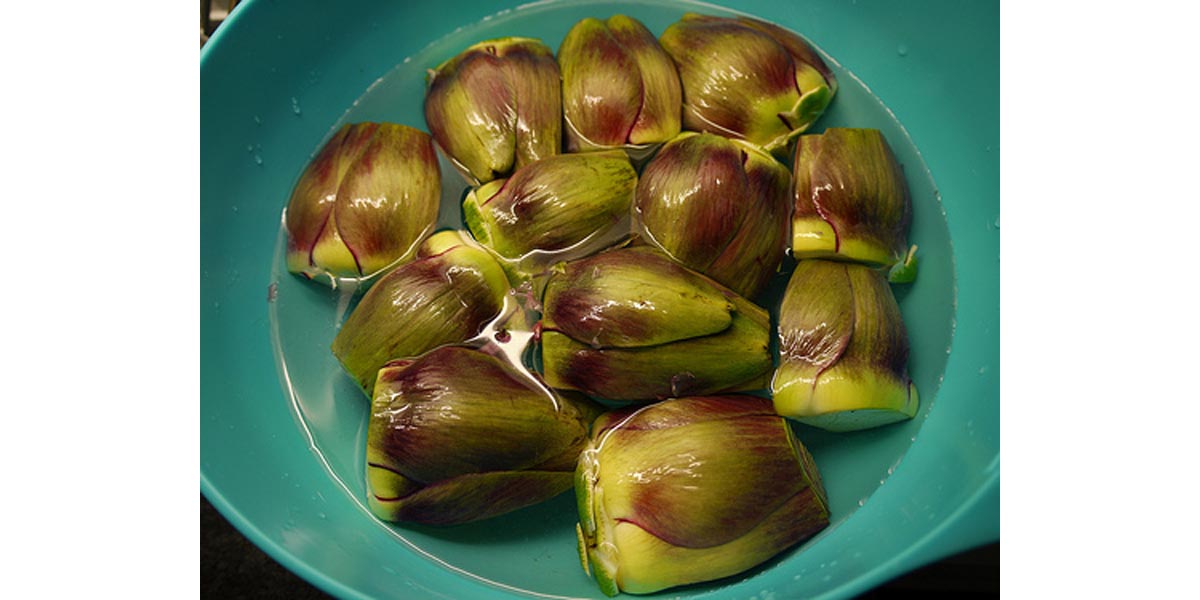It is the heart of the globe artichoke that many find so appealing, however the leaves, themselves are edible at the end of the leaf that is attached to the heart.
The globe artichoke, a curious-looking vegetable that you're sure to want to bring home if you spot it at the grocery store, is actually a thistle that originates in southern Europe and the Mediterranean. The flowers of the thistle form what is known as the edible bud, which has many layers of scales.
Just looking at a globe artichoke is sure to make you feel intimidated, though — and if you're wondering how on earth to prepare this beauty, we've got answers for you.
Where are Globe Artichokes Grown and How to Grow Them?

The globe artichoke needs a warm climate to grow and produce the edible bud. They do not tolerate frost as frost will stunt or kill the plant. The seeds should be sown approximately five inches apart from one another in rows that are at least 5 to 6 feet apart. The seeds should be planted about one inch below the soil. The seeds and young plants need to be watered at least 3 to 5 times per week during the hottest part of the day, unlike many other vegetables. Globe artichoke plants are susceptible to insects and need to be cared for to prevent infestations of aphids which are generally drawn to the buds as they flower. The globe artichoke generally takes 90 to 100 days to mature and most do not produce the buds the first year. The plants should be harvested when the bud starts to open. Cutting the globe artichoke 2 to 3 inches down from the bud will allow it to flower and produce a second bud for harvesting.
Nutrients Found in Globe Artichoke
The globe artichoke is a good source for Vitamin C which is essential to help promote a strong and healthy immune system by fighting off harmful free radicals that tend to destroy healthy cells and are known to be cancer causing agents.They are also high in potassium which helps to balance the fluids in the body and maintain a normal and steady heartbeat. Potassium is also needed to help send impulses from the nerves to make the muscles contract.
Globe artichokes are an excellent source of dietary fiber which is very helpful in maintaining a regular digestive system and reduce or eliminate constipation.
They are rich in Vitamin K which helps the body produce the clotting factor needed in the healing of wounds.
The globe artichoke is low in cholesterol and saturated fats which makes this an excellent food choice to maintain a healthy heart and reduce the risk of heart disease.
Healthy ways to Prepare Globe Artichoke
The globe artichoke is best served after boiling the vegetable until the stems are tender. Steaming them is best as it helps to hold the nutritional value of the food as it is being cooked while preserving taste at the same time. Globe artichokes can also be baked slowly with a healthy stuffing imbedded between the leaves, which leads to a rich Mediterranean flavor when sprinkled with olive oil, garlic, and sea salt. Globe artichokes can be served hot or cold and are equally tasty in both cases; salads are a great place to put your globe artichokes, but so are pastas. The fat ends of the leaves are edible as you remove them from the stalk; the heart is below the leaves and filled with inedible “chokes” and should be spooned out before eating the heart.Health Benefits of Globe Artichoke
In an article released by Harvard Medical School it was stated that niacin, which is found in good supply in globe artichokes, is beneficial in lowering the bad cholesterol in the blood and increasing the good cholesterol. Lowering the bad cholesterol is imperative to keeping arteries from clogging and causing heart disease.Globe artichokes are a good source of folate which is known to help prevent birth defects.
They are high in Vitamin C which is an antioxidant and helps to protect the body from infection and helps to build a strong immune system.
Because the globe artichoke is an excellent source of dietary fiber, adding this food to your diet can help keep your digestive system functioning regularly.
- Resources: http://en.wikipedia.org/wiki/Globe_artichoke
- www.health.harvard.edu/healthbeat/HB_web/Nutritions-dynamic-duos.htm#art1
- Photo courtesy of Tristanf on Flickr: www.flickr.com/photos/tristanf/4399490268/


Your thoughts on this